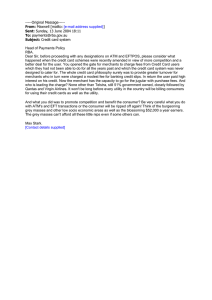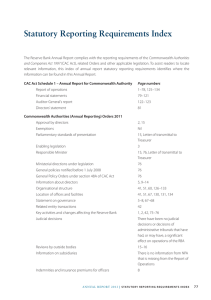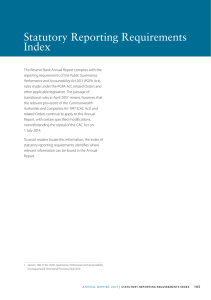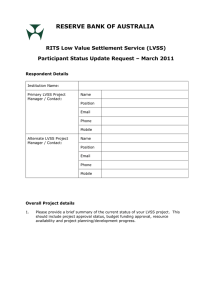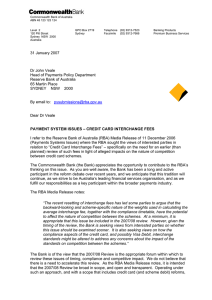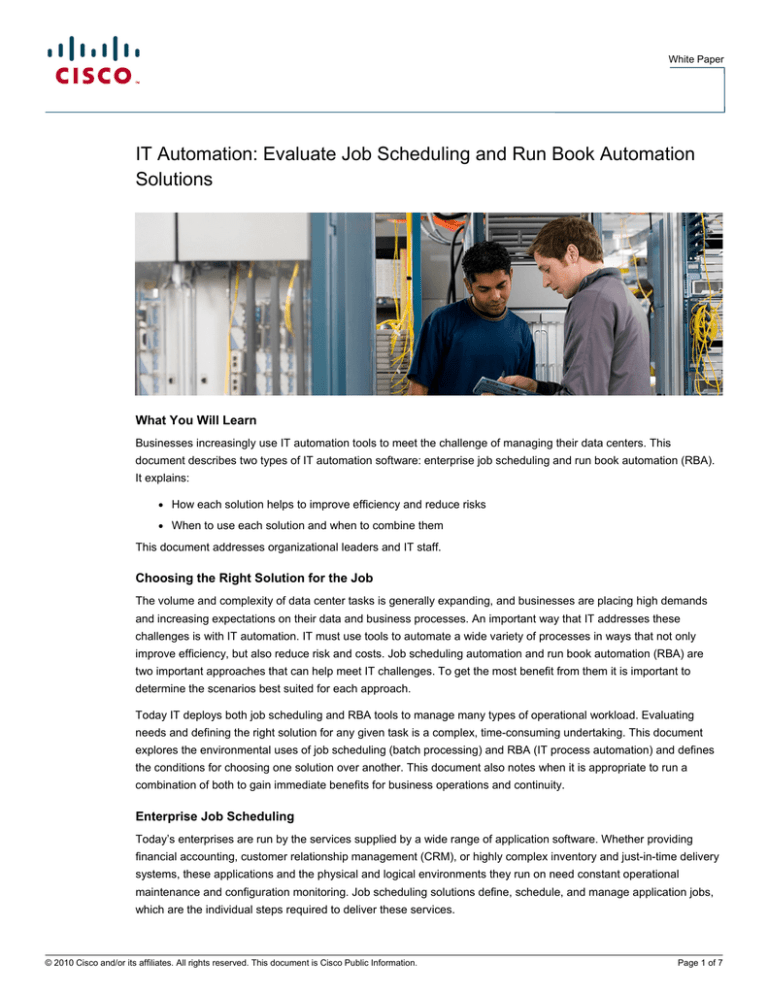
White Paper
IT Automation: Evaluate Job Scheduling and Run Book Automation
Solutions
What You Will Learn
Businesses increasingly use IT automation tools to meet the challenge of managing their data centers. This
document describes two types of IT automation software: enterprise job scheduling and run book automation (RBA).
It explains:
●
How each solution helps to improve efficiency and reduce risks
●
When to use each solution and when to combine them
This document addresses organizational leaders and IT staff.
Choosing the Right Solution for the Job
The volume and complexity of data center tasks is generally expanding, and businesses are placing high demands
and increasing expectations on their data and business processes. An important way that IT addresses these
challenges is with IT automation. IT must use tools to automate a wide variety of processes in ways that not only
improve efficiency, but also reduce risk and costs. Job scheduling automation and run book automation (RBA) are
two important approaches that can help meet IT challenges. To get the most benefit from them it is important to
determine the scenarios best suited for each approach.
Today IT deploys both job scheduling and RBA tools to manage many types of operational workload. Evaluating
needs and defining the right solution for any given task is a complex, time-consuming undertaking. This document
explores the environmental uses of job scheduling (batch processing) and RBA (IT process automation) and defines
the conditions for choosing one solution over another. This document also notes when it is appropriate to run a
combination of both to gain immediate benefits for business operations and continuity.
Enterprise Job Scheduling
Today’s enterprises are run by the services supplied by a wide range of application software. Whether providing
financial accounting, customer relationship management (CRM), or highly complex inventory and just-in-time delivery
systems, these applications and the physical and logical environments they run on need constant operational
maintenance and configuration monitoring. Job scheduling solutions define, schedule, and manage application jobs,
which are the individual steps required to deliver these services.
© 2010 Cisco and/or its affiliates. All rights reserved. This document is Cisco Public Information.
Page 1 of 7
White Paper
In a typical job scheduling environment, there is a centralized scheduling platform with a set of on-demand
technologies to support its functions. The IT operations and core scheduling teams interact with the scheduler
through a client tier or a Web interface. Traditionally, job scheduling solutions performed their work using platformspecific agents, including Microsoft Windows, UNIX, Linux, and mainframe operating systems. However, in the past
five years, there has been a shift toward managing jobs by directly connecting to a targeted application. This shift
requires writing plug-in modules that connect through vendor-supplied APIs to interact directly with enterprise
resource planning (ERP) and CRM solutions, such as SAP, Oracle E-Business Suite, PeopleSoft, and JD Edwards.
Connections to custom-developed applications are generally managed through the use of web services integrations
or the delivery of jobs onto enterprise service buses (ESBs) through Java Message Service (JMS), or by creating
connections to Java applications by using JavaBeans.
There has also been an effort to integrate and schedule jobs using the latest business intelligence, data warehouse,
and extract, transform, load (ETL) applications. These solutions require integration of database activities. The
solutions process data from multiple applications across the enterprise to deliver the business insight required to
make the right strategic decisions at the right time. Managing dependency logic and automating job step sequencing
are critical to the delivery of relevant and timely information for strategic decision making.
Job scheduling solutions can also manage file delivery, backup, and storage processes. More recently, job
schedulers have been integrated with virtualization solutions and certain cloud services that have the capability to
schedule jobs in a virtualized environment.
Keeping track of the internal and external job operations environment requires job schedulers to have formal
operational reporting tools that deliver information about critical job run activities. This process includes delivery of
information to specific targets or administrators through file, email, database, and simple network management
protocol (SNMP).
Job Scheduling Automation
Job scheduling automation allows data center administrators to automatically define and run a set of business
processes between different applications. This automation provides control and visibility over an entire job processing
environment. Workflows - the logical description of a series of jobs - integrate and orchestrate business processes
from distributed logical and physical application stacks and from various ERP systems.
A number of environmental and job-specific criteria can be automated. One of the most important is the timing of
when a job and workflows will run. Job scheduling tools can manage complex business calendars. Jobs can be set to
run in relation to specific business needs, such as end-of-quarter financial reporting or biweekly payroll runs. Different
business units have different needs and operate on different calendars. Automation tools must be able to meet those
needs, yet be flexible enough to manage any time-based situation.
In conjunction with time-based schedules, job schedulers must also launch jobs using event-based triggers. Triggers
can include any system event, environmental actions, completion of other jobs, file variables, email triggers, database
changes, and even changes in a virtual environment. A business process workflow may have a time window, but it
may also need a specific file to be delivered from an outside partner or vendor to execute successfully. In this case,
jobs can be defined to have a dependency on some other event, action, or file before running. Jobs can also be
managed based on specific environmental variables, such as the availability of a resource stack or specific network
bandwidth. Event-based automation provides a means of removing latency from batch business processes and
allows IT to be more responsive to the evolving needs of the business by delivering complex workflows faster.
Because job schedulers perform such a vital role by automating critical business processes, they must be able to
generate alerts and take subsequent automated actions when something unexpected happens within the processing
environment. A scheduler’s alert and recovery management capabilities should be flexible enough to handle a wide
© 2010 Cisco and/or its affiliates. All rights reserved. This document is Cisco Public Information.
Page 2 of 7
White Paper
range of potential errors. They should also be extensible enough to identify and manage events that the user
chooses.
Automated recovery features and their corresponding alerts should respond differently to different types of events. In
fact, alert management and autorecovery often need to work in conjunction. In a typical scenario, a job may fail,
which would then initiate some type of recovery action and also notify a designated administrator of the failure. This
notification may be in the form of an email, an XML page, or an SNMP message sent to a central management
console. This messaging function should allow acknowledgment of the alert so that the job scheduling tool is
informed when the appropriate person has received it.
Typically, a disposition occurs at the end of a job run. Alerts can be triggered to notify IT staff, and files may need to
be printed, saved, or deleted. Another important set of automated tasks is status outputs, which can include logs,
reports, exit status, and the results of jobs generated by complex workflows.
From a process-delivery perspective, after the scheduling environment is defined and jobs are created and running,
IT operations staff can monitor all job activities and events. Job scheduling automation allows IT to focus on defining,
running, and recovering complex application jobs. Its greatest benefit is to provide IT with effective tools to deliver
accurate and timely application processing demands from various business units.
In scenarios in which job scheduling automation manages specific business process functions, such as financial or
inventory ERP jobs, RBA looks at the entire data center environment from a holistic and preventive orchestration
perspective. Before looking at what RBA does, consider the larger issues of managing a complex data center.
Managing Complex Data Center Operational Processes
In addition to delivering services to various business units, IT is responsible for the day-to-day operational readiness
of those services. That responsibility includes a number of critical functional elements, such as the hardware and
software stack (machine, memory, OS layer, and applications), database administration, network administration, data
storage and recovery, and security surrounding the entire infrastructure.
According to Forrester Research, the combination of human error and application-layer errors accounts for 80
percent of data center outages. These errors include testing errors, ineffective change management, configuration
problems, undocumented or improperly documented procedures, failures in knowledge transfer, failure to obtain
approvals, and other violations of company policy. The following examples provide an overview of how human and
manual processes can affect IT operations.
Lack of Proper Approvals
Managers usually approve critical process execution so that each action creates an audit trail. However, the approval
process may change as administrators assume new roles. Many companies expand the number of processes that
require approval or levels of approval during end-of-month, end-of-quarter, and end-of-year processing. Staff
members who are unaware of these changes could likely fail to get the proper approvals.
Inconsistent Process
Staff members may use different processes, which can result in inconsistent outcomes. Clearly, consistent process
execution delivers better, more predictable service, while inconsistent process execution results in erratic service,
slower problem resolution, and wasted IT resources.
Inability to Monitor and Refine Process
A primary objective in managing an IT department is to improve process efficiency and effectiveness. An organization
that is unsure of a process being followed or the conditions necessary for its success will find it difficult to make
improvements.
© 2010 Cisco and/or its affiliates. All rights reserved. This document is Cisco Public Information.
Page 3 of 7
White Paper
Delegation of Routine Tasks
If IT departments can securely delegate processes (even those requiring administrative privileges), productivity can
be improved and expensive resources can be directed toward developing and implementing technical innovations.
Failure to Consistently Perform Preventive Maintenance
Numerous processes should be run regularly to locate emerging problems. If this task is left undone due to
inconsistent process adherence, the result will be degraded service or service outages.
Use of RBA tools can eliminate these human and procedural errors, freeing high-value resources for mission-critical
innovation projects.
Run Book Automation in the Data Center
Automation of jobs and their associated workflows has the goal of creating a system in which no human involvement
is needed for time-based and event-based batch processing. The best day in an operations center is one in which job
scheduling runs perfectly and there are no reruns, faults, or errors. RBA, however, assumes some form of human
involvement at critical points in the operations infrastructure management process and attempts to guide
administrators through a set of predefined steps to deliver the intended outcome.
RBA is a process orchestration methodology that encompasses the entire IT infrastructure. Whereas job scheduling
automation focuses on delivering services to business units in the form of job execution output, RBA focuses on the
health and efficiency of the IT operations stack by tracking and reducing mean time to repair (MTTR) and increasing
mean time between failure (MTBF) values and averages - statistics that describe data center reliability and stability.
Another RBA deliverable consists of processes that help provision computing resources and manage resource
utilization. RBA allows IT to transition from managing discrete applications and devices to delivering tightly integrated
enterprise services using a series of documented, step-by-step instructions. Automation can be instrumental in
attaining the proper balance between process and flexibility by helping organizations achieve greater operational
accuracy.
Incident response times are also a crucial factor in IT operations service delivery. While many data centers use
advanced monitoring and performance tracking tools, the remediation steps are usually performed using manual
procedures that introduce errors and operational risk into the recovery processes. The following examples illustrate
how RBA can automate infrastructure procedures to provide better control, greater visibility, and ultimately, reduced
costs.
Corrective Action
RBA tools automate commonly repeated processes for incident and alert diagnosis and resolution. Automated
response can take many forms, such as sending an email to the correct administrator or invoking complex
remediation steps that can be fully or partly automated to guide administrators through a series of step-by-step
processes. This type of automation can reduce alert floods, empower frontline operations, and reduce escalations.
Preventive Maintenance
The day-to-day routine of managing recurring software maintenance and health check diagnostics usually consists of
impromptu processes that can be complicated by unnecessary human intervention. RBA tools can eliminate the
error-prone management of many of these recurring tasks, significantly increasing the efficiency of administrative
staff and reducing human-induced errors.
Change and Compliance Orchestration
From a business-continuity perspective, RBA solutions can integrate with Information Technology Infrastructure
Library (ITIL) domain of change and configuration management, service decks integration, and quality control gates.
© 2010 Cisco and/or its affiliates. All rights reserved. This document is Cisco Public Information.
Page 4 of 7
White Paper
RBA helps IT manage change uniformly across all infrastructure tiers for application configuration enforcement and
process compliance, and it provides an automatic audit trail.
Process Step Orchestration
RBA can deliver end-to-end processes across IT tools and departmental silos. This orchestration reinforces IT best
practices, provides smooth integration across supporting tools, and provides unified visibility and control.
Security Access
When error remediation issues arise and manual intervention is necessary, administrators may need credentialed
access that they have not been granted. An RBA tool can be configured to allow item- or task-specific controls. This
provides task rights to staff without providing root access. By automating security privileges through the use of highly
specific process flow authorization, IT staff can act immediately without having to locate and secure approvals for
impromptu access rights. MTTR metrics and staff overhead will quickly be reduced due to faster error recovery. Also,
security can be automated in the form of preventive management. Processes can be defined to eliminate
unauthorized configuration changes, so that environments can be locked down to let the RBA tool, with its robust
security model, define who has access to which processes and which steps each staff member can perform.
Change Management
Manual and case-by-case processes for change management may take weeks for end-to-end system refreshes,
patch integrations, middleware changes, storage changes, allocation of network resources, or just deployment of the
server application database. Centralized visibility of process integration is necessary for data center infrastructure
automation. The deployment of many different specific solutions results in disconnected processes, so deploying a
single-pane RBA solution to orchestrate these processes is critical.
Environmental Triage
RBA can add great value to service operations. A typical IT environment has a variety of software, hardware, and
network resources. Often these environments, connected to a management console, are full of alerts and events
continuously delivered to the service desk console. RBA allows administrators to prioritize incoming events by
categorizing and automatically intervening in low-level actions and escalating only those incidents that need
administrator-level intervention. RBA can then be designed to alert the right administrator and take corrective action.
Unlocking Valuable Staff Time
Domain experts are constantly distracted by the needs of operations administrators. Those individuals with deep
expertise would benefit from a sophisticated RBA tool to reduce MTTR and MTTF and to decrease the effects on
customers, because their collective knowledge would be built into the RBA content library. These experts could then
deliver more value to the business by concentrating on mission-critical innovation projects.
Managing Virtual Resources
The move to virtualization has actually created more complexity in the data center, resulting in increased risk levels.
RBA can help reduce the human errors involved in managing preventive automation tasks and routine resource
provisioning. RBA tools can also perform automated configuration tasks through streamlined release and
deployment.
© 2010 Cisco and/or its affiliates. All rights reserved. This document is Cisco Public Information.
Page 5 of 7
White Paper
Choosing the Right Tool for the Job
Following are a few examples of typical job scheduling automation and RBA solutions in practice.
The traditional realm of the job scheduler has been the automation of enterprise and custom ERP and CRM process
workflows. Automation may include management of inventory supply chains for a manufacturer or retailer or quarterend closing of the general ledger in a technology company. An enterprise job scheduling solution will easily connect
to physically and logically distributed systems, various enterprises, and custom application stacks, while managing
detailed schedules over multiple time zones.
Another job scheduling example is the management of a market data system in which a variety of financial end users
receive multiple feeds from external data sources. A job scheduling solution automates all these processes to get the
right data to the right place at the right time.
Finally, job schedulers are ideally suited for managing data integration (ETL) processes, while delivering the output to
downstream data warehousing and business intelligence reporting tools. Job scheduling solutions are the right tools
to promote this kind of activity, especially when it is performed in conjunction with upstream ERP workflows. In this
case, the job scheduling solution is delivering an automated enterprisewide workflow solution.
Examples of RBA and service operational process automation include incident management, infrastructure
maintenance, and deployment provisioning. RBA helps data center administrators isolate the location of incidents
within a complex application environment residing in a complex infrastructure.
RBA also handles internal and business unit operation service requests. Internal requests may include SAP system
copies, health checks, and system refreshes, or, in an Oracle E-Business environment, the automation of daily and
weekly checks, diagnostic routines, backups, and management of database space.
Where the Choice Between RBA and Job Scheduling Automation Is Not Clear
Depending on how the lines of operational responsibility are drawn, an operations team may be responsible for
preventive health checks and configuration management using RBA tools, whereas service delivery, application
availability, and job-run error management may be managed by a job scheduling team. As a result, the choice of
which tool to use is not always obvious.
The following are examples in which the decision between RBA and job scheduling automation is ambiguous, where
either solution may be the right choice, or where (in complex situations) both tools are necessary to enable a data
center operating at optimal efficiency to deliver on business unit requests with speed and accuracy.
Scheduling a Backup Operation
Data backup has typically been managed by job scheduling automation tools. In a complex data center, these tasks
may be managed with RBA solutions if they involve daily or routine storage management processes.
Disaster Recovery Planning and Execution
Both job scheduling and RBA tools may be necessary for managing large enterprise disaster recovery procedures.
RBA may take an administrator through the provisioning steps, and a job scheduler could manage application output
steps. Typically, though, RBA solutions manage complex disaster recovery processes.
Cloud Orchestration and Virtual Machine Resource Orchestration
When a virtual data center is up and running, typically core and stack configurations are constantly changing. Virtual
machines are added, application stacks are provisioned, and resources are used on demand or taken offline,
depending on the defined load balancing or efficiency utilization parameters. In this case, both solutions may be
necessary to optimize both automated job runs and administrator-aided configuration maintenance and monitoring
using RBA tools.
© 2010 Cisco and/or its affiliates. All rights reserved. This document is Cisco Public Information.
Page 6 of 7
White Paper
If an environment has different domains of control, operational silos, or security constraints, the ownership of the
process and what is being managed changes. How and when to automate these processes must be considered.
Improving Operational Excellence by Automating IT Processes
Cisco® Tidal Enterprise Orchestrator is designed to be the foundation on which to standardize, unify, and automate
best practices for IT infrastructure processes that are used in complex, heterogeneous data center environments.
Using automated maintenance, deployment, infrastructure service requests, and incident management run books,
Cisco Tidal Enterprise Orchestrator frees staff to address strategic business objectives.
By automating the infrastructure management process and putting automated best practices in place, IT can reduce
the time and effort spent on repetitive maintenance procedures, housekeeping tasks, and support routines. This
approach enables IT departments to control costs, improve efficiency, and speed service delivery to the business.
Managing Enterprise Workloads with Automated Job Scheduling Solutions
Cisco offers an extremely easy-to-use enterprise job scheduler, Cisco Tidal Enterprise Scheduler, for completely
automating even the most complex batch processing across the enterprise. With an intuitive GUI, Cisco Tidal
Enterprise Scheduler is a powerful solution that enterprises can use as a standard because it offers a scalable,
distributed architecture that operates across platforms, such as Microsoft Windows, UNIX, Linux, IBM z/OS and
OS/400, HP OVMS, and many others. It also transparently integrates with leading applications from SAP and Oracle,
including PeopleSoft and Oracle E-Business Suite, leading business intelligence and data warehousing solutions,
and many commonly used industry-specific applications, such as those used in banking, retail, and other industries.
Used in some of the most demanding data centers in the world, Cisco Tidal Enterprise Scheduler job scheduling
software can be implemented quickly to support rapid streamlining of batch processing and contribute to overall data
center efficiency.
Whether an enterprise needs to automate workflows within a highly complex and distributed application environment
or requires automated incident management, infrastructure maintenance, and deployment provisioning, Cisco offers
the right solution.
For More Information
To learn more about Cisco products and services, please visit http://www.cisco.com.
Printed in USA
© 2010 Cisco and/or its affiliates. All rights reserved. This document is Cisco Public Information.
C11-633296-00
11/10
Page 7 of 7


